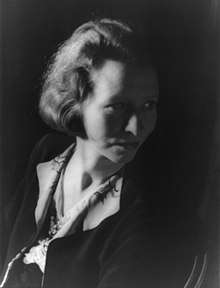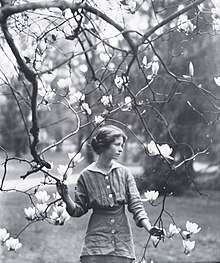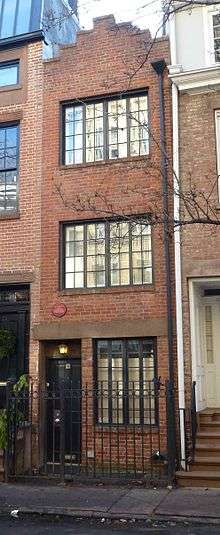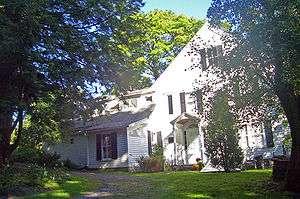Edna St. Vincent Millay
Edna St. Vincent Millay (February 22, 1892 – October 19, 1950) was an American lyrical poet and playwright.[1] She received the Pulitzer Prize for Poetry in 1923, the third woman to win the award for poetry,[2] and was also known for her feminist activism. She used the pseudonym Nancy Boyd for her prose work. The poet Richard Wilbur asserted, "She wrote some of the best sonnets of the century."[3]
Edna St. Vincent Millay | |
|---|---|
 Edna St. Vincent Millay, photographed by Carl Van Vechten, 1933 | |
| Born | February 22, 1892 Rockland, Maine, US |
| Died | October 19, 1950 (aged 58) Austerlitz, New York, US |
| Pen name | Nancy Boyd |
| Occupation | Poet |
| Nationality | American |
| Alma mater | Vassar College |
| Notable awards | Pulitzer Prize for Poetry (1923) Robert Frost Medal (1943) |
Early life
Millay was born in Rockland, Maine, to Cora Lounella Buzelle, a nurse, and Henry Tolman Millay, a schoolteacher who would later become a superintendent of schools. Her middle name derives from St. Vincent's Hospital in New York, where her uncle's life had been saved just before her birth. The family's house was "between the mountains and the sea where baskets of apples and drying herbs on the porch mingled their scents with those of the neighboring pine woods."[4] In 1904, Cora officially divorced Millay's father for financial irresponsibility and domestic abuse, but they had already been separated for some years. Henry and Millay kept a letter correspondence for many years, but he never re-entered the family. Cora and her three daughters, Edna (who called herself "Vincent"), Norma Lounella (born 1893), and Kathleen Kalloch (born 1896), moved from town to town, living in poverty and surviving various illnesses. Cora travelled with a trunk full of classic literature, including Shakespeare and Milton, which she read to her children. The family settled in a small house on the property of Cora's aunt in Camden, Maine, where Millay would write the first of the poems that would bring her literary fame.

The three sisters were independent and spoke their minds, which did not always sit well with the authority figures in their lives. Millay's grade school principal, offended by her frank attitudes, refused to call her Vincent. Instead, he called her by any woman's name that started with a V.[6] At Camden High School, Millay began developing her literary talents, starting at the school's literary magazine, The Megunticook. At 14 she won the St. Nicholas Gold Badge for poetry, and by 15, she had published her poetry in the popular children's magazine St. Nicholas, the Camden Herald, and the high-profile anthology Current Literature.
Millay entered Vassar College in 1913 when she was 21 years old, later than usual. Her attendance at Vassar became a strain to her due to its strict nature. Before she attended the college Millay had a liberal home life that included smoking, drinking, playing gin rummy, and flirting with men. Vassar, on the other hand, expected its students to be refined and live according to their status as young women.[7] She had relationships with many fellow students during her time there and kept scrapbooks including drafts of plays written during the period.[6][8] While at school, she had several relationships with women, including Edith Wynne Matthison, who would go on to become an actress in silent films.[9]
New York City

After her graduation from Vassar in 1917, Millay moved to New York City. She lived in a number of places in Greenwich Village, including a house owned by the Cherry Lane Theatre[10] and 75½ Bedford Street, renowned for being the narrowest[11][12] in New York City.[13] While in New York City, Millay lived an openly bisexual lifestyle.[7] The critic Floyd Dell wrote that the red-haired and beautiful Millay was "a frivolous young woman, with a brand-new pair of dancing slippers and a mouth like a valentine."[4] Millay described her life in New York as "very, very poor and very, very merry." While establishing her career as a poet, Millay initially worked with the Provincetown Players on Macdougal Street and the Theatre Guild. In 1924 Millay and others founded the Cherry Lane Theater "to continue the staging of experimental drama."[14] Magazine articles under a pseudonym also helped support her early days in the Village.[4] During her stay in Greenwich Village, Millay learned to use her poetry in her feminist activism. She often went into detail about topics others found taboo, such as a wife leaving her husband in the middle of the night.[7]
Counted among Millay's close friends were the writers Witter Bynner, Arthur Davison Ficke, and Susan Glaspell, as well as Floyd Dell and the critic Edmund Wilson, both of whom proposed marriage to her and were refused.[9][15] Millay had a way of wrapping men around her finger, even after she rejected them.[7] Edmund Wilson, for example, spoke of her highly because Millay took his virginity but she recanted of his advances and rejected his marriage proposal, but he remained a loyal friend.[7]
Career
Millay's fame began in 1912 when, at the age of 20, she entered her poem "Renascence" in a poetry contest in The Lyric Year. The poem was widely considered the best submission, and when it was ultimately awarded fourth place, it created a scandal which brought Millay publicity. The first-place winner Orrick Johns was among those who felt that "Renascence" was the best poem, and stated that "the award was as much an embarrassment to me as a triumph." A second-prize winner offered Millay his $250 prize money.[16] In the immediate aftermath of the Lyric Year controversy, wealthy arts patron Caroline B. Dow heard Millay reciting her poetry and playing the piano at the Whitehall Inn in Camden, Maine, and was so impressed that she offered to pay for Millay's education at Vassar College.[17]
After graduating from Vassar, Millay moved to Greenwich Village. A friend remembered seeing her red hair flying as she ran down MacDougal Street, “flushed and laughing like a nymph.”[18] She would soon fall out of love, bluntly answering a marriage proposal: "Never ask a girl poet to marry you."[19] Holed up in a small, unheated apartment, she began to write shorter, pithier poems.
Millay’s 1920 collection A Few Figs From Thistles drew controversy for its exploration of female sexuality and feminism.[20] In 1919, she wrote the anti-war play Aria da Capo, which starred her sister Norma Millay at the Provincetown Playhouse in New York City. Millay won the Pulitzer Prize for Poetry in 1923 for "The Ballad of the Harp-Weaver";[21] she was the third woman to win the poetry prize, after Sara Teasdale (1918) and Margaret Widdemer (1919).[22]
Millay also wrote short stories for the magazine Ainslee's - but she was a canny protector of her identity as a poet and an aesthete, and insisted on publishing this more mass-appeal work under a pseudonym, Nancy Boyd. As her fame grew and she became a household name, the publisher of Ainslee's offered to double her fees if he could use her real name. She refused.
In January 1921, she went to Paris, where she met and befriended the sculptors Thelma Wood[23] and Constantin Brancusi, photographer Man Ray, had affairs with journalists George Slocombe and John Carter, and became pregnant by a man named Daubigny. She secured a marriage license but instead returned to New England where her mother Cora helped induce an abortion with alkanet, as recommended in her old copy of ''Culpeper's Complete Herbal''.[24]

Possibly as a result, Millay was frequently ill and weak for much of the next four years.
After experiencing his remarkable attentions to her during her illness, in 1923 she married 43-year-old Eugen Jan Boissevain (1880–1949), the widower of the labor lawyer and war correspondent Inez Milholland, a political icon Millay had met during her time at Vassar.[25] A self-proclaimed feminist, Boissevain supported Millay’s career and took primary care of domestic responsibilities. Both Millay and Boissevain had other lovers throughout their 26-year marriage. For Millay, one such significant relationship was with the poet George Dillon, a student 14 years her junior, whom she met in 1928 at one of her readings at the University of Chicago. Their relationship inspired the sonnets in the collection Fatal Interview (published 1931).[26]
In 1925, Boissevain and Millay bought Steepletop near Austerlitz, New York, which had once been a 635-acre (257 ha) blueberry farm.[27] They built a barn (from a Sears Roebuck kit), and then a writing cabin and a tennis court. Millay grew her own vegetables in a small garden.[27][28] Later, they bought Ragged Island in Casco Bay, Maine, as a summer retreat.[29] Frequently having trouble with the servants they employed, Millay wrote, "The only people I really hate are servants. They are not really human beings at all."[30]
In the summer of 1936, Millay was riding in a station wagon when the door suddenly swung open, and Millay “was hurled out into the pitch-darkness...and rolled for some distance down a rocky gully"[31] The accident severely damaged nerves in her spine, requiring frequent surgeries and hospitalizations, at least daily doses of morphine. Millay lived the rest of her life in "constant pain".[32] Despite this, she was sufficiently alarmed by the rise of fascism to write against it. During World War I, Millay had been a dedicated and active pacifist; however, in 1940 she advocated for the U.S. to enter the war against the Axis and became an ardent supporter of the war effort. She later worked with Writers' War Board to create propaganda, including poetry.[33] Millay’s reputation in poetry circles was damaged by her war work. Merle Rubin noted, "She seems to have caught more flak from the literary critics for supporting democracy than Ezra Pound did for championing fascism."[34] In 1942 in The New York Times Magazine, Millay mourned the destruction of the Czechoslovak town of Lidice. Nazi forces had razed Lidice, slaughtered its male inhabitants and scattered its surviving residents in retaliation for the assassination of Reinhard Heydrich. Millay wrote:
The whole world holds in its arms today
The murdered village of Lidice,
Like the murdered body of a little child.[4]
This article would serve as the basis of her 32-page poem, "Murder of Lidice", in 1942[35] and loosely served as the basis of the 1943 MGM movie Hitler's Madman.[36] Douglas Sirk directed the movie. Harper and Brothers published the poem in 1942.[35]
In 1943, Millay was the sixth person and the second woman to be awarded the Frost Medal for her lifetime contribution to American poetry.
Despite the excellent sales of her books in the 1930s, her declining reputation, constant medical bills, and frequent demands from her mentally-ill sister Kathleen meant that for most of her last years, Millay was in debt to her own publisher.[37] Author Daniel Mark Epstein also concludes from her correspondence that Millay developed a passion for thoroughbred horse-racing, and spent much of her income investing in a racing stable of which she had quietly become an owner.[38] Boissevain died in 1949 of lung cancer, and Millay lived alone for the last year of her life.
Death and legacy
Millay died at her home on October 19, 1950. She had fallen down stairs and was found approximately eight hours after her death. Her physician reported that she had suffered a heart attack following a coronary occlusion.[4][39][40] She was 58 years old. She is buried alongside her husband at Steepletop, Austerlitz, New York.[41]
Millay's sister Norma and her husband, the painter and actor Charles Frederick Ellis, moved to Steepletop after Millay's death. In 1973, they established Millay Colony for the Arts on the seven acres around the house and barn. After the death of her husband in 1976, Norma continued to run the program until her death in 1986.[27]

At 17, the poet Mary Oliver visited Steepletop and became a close friend of Norma. Oliver eventually lived there for seven years and helped to organize Millay's papers.[42] Mary Oliver herself went on to become a Pulitzer Prize-winning poet, greatly inspired by Millay's work.[43] In 2006, the state of New York paid $1.69 million to acquire 230 acres (0.93 km2) of Steepletop, to add the land to a nearby state forest preserve. The proceeds of the sale were used by the Edna St. Vincent Millay Society to restore the farmhouse and grounds and turn it into a museum. The museum opened to the public in the summer of 2010, and guided tours of Steepletop and Millay's gardens were available from the end of May through the middle of October. Effective November 2018 Steepletop closed to the public due to financial challenges and restoration needs. Fundraising efforts continue as do considerations for the future of this museum house.[44]
Parts of the grounds of Steepletop, including the Millay Poetry Trail that leads to her grave, are now open for occasional scheduled events.[45]
Details of Millay's life were compiled by biographer Nancy Milford in the book titled Savage Beauty: The Life of Edna St Vincent Millay, published in 2001. Milford was sought out by Millay's only living connection at the time, her sister Norma Millay Ellis, and was chosen for her previous, successful biography Zelda. Milford would then go on to edit and write an introduction for a collection of Millay's poems called The Selected Poetry of Edna St. Vincent Millay.[46]
In 2015, Millay was named by Equality Forum as one of their 31 Icons of the 2015 LGBT History Month.[47]
Millay has been the inspiration for several plays and musicals, including the biographical play Words Like Fresh Skin, written by Megan Lohne and produced at Adelphi University.[48]
In the 1971 All in the Family episode "Judging Books by Covers," the character Archie Bunker erroneously refers to the poet as "Edna St. Louis Millay."[49]
In 1975 on the Waltons season three episode entitled 'The Woman,' a female poet visiting the college attended by John Boy quotes Edna St. Vincent Millay, reciting 'The First Fig': "My candle burns at both ends/ It will not last the night/ But ah, my foes and oh my friends/ It gives a lovely light"
In July of 1981, the U.S. Postal Service issued an 18-cent stamp depicting Edna St. Vincent Millay.
Works
My candle burns at both ends;
It will not last the night;
But ah, my foes, and oh, my friends—
It gives a lovely light!
"First Fig"
from A Few Figs from Thistles (1920)[50]
Millay wrote six verse dramas early in her career, including Two Slatterns and a King and The Lamp and the Bell, a poem written for Vassar College about love between women.[9] She was commissioned by the Metropolitan Opera House to write a libretto for an opera composed by Deems Taylor. The result, The King's Henchman, drew on the Anglo-Saxon Chronicle's account of Eadgar, King of Wessex, and was described as the most effectively and artistically wrought American opera ever to reach the stage. Within three weeks, her publishers had run through four editions of the book.[4]
Her pacifist verse drama Aria da Capo, a one-act play written for the Provincetown Players, is often anthologized. It aired live as an episode of Academy Theatre in 1949 on NBC.
"Euclid alone has looked on Beauty bare" (1922) is an homage to the geometry of Euclid.[51] "Renascence"[52] and "The Ballad of the Harp-Weaver"[53] are often considered her finest poems. On her death, The New York Times described her as "an idol of the younger generation during the glorious early days of Greenwich Village [...] One of the greatest American poets of her time."[4] Thomas Hardy said that America had two great attractions: the skyscraper and the poetry of Edna St. Vincent Millay.[54]
Publications
See also
References
- Obituary Variety, October 25, 1950.
- "Poetry". www.pulitzer.org.
- Millay, Edna St. Vincent. Selected Poems. Harper Collins, 1991
- "Edna St. V. Millay Found Dead At 58", The New York Times (obituary), October 20, 1950, retrieved September 13, 2010.
- 1869-1942, Genthe, Arnold (September 24, 2018). "Edna St. Vincent Millay at Mitchell Kennerley's house in Mamaroneck, New York". www.loc.gov.CS1 maint: numeric names: authors list (link)
- Epstein, Daniel Mark (2001). What Lips My Lips Have Kissed: The Loves and Love Poems of Edna St. Vincent Millay. New York: Henry Holt. ISBN 0-8050-6727-2.
- MILLAY, VINCENT (September 5, 2005), "EDNA ST. VINCENT MILLAY", Lofty Dogmas, University of Arkansas Press, pp. 248–250, ISBN 978-1-61075-244-2, retrieved April 29, 2020
- Brinkman, B. "Modern American Archives and Scrapbook Modernism." The Cambridge Companion to Modern American Poetry (2015):
- Millay, Edna St. Vincent (February 4, 2014). "Edna St. Vincent Millay". Edna St. Vincent Millay.
- Nevius, Michelle and James (2009). Inside the Apple: A Streetwise History of New York City. New York: Free Press.
- Gray, Christopher (November 10, 1996). "For Rent: 3-Floor House, 9 1/2 Ft. Wide, $6,000 a Month". The New York Times. Retrieved December 14, 2015.
- Barbanel, Josh (September 19, 2013). "Grand on a Small Scale". The Wall Street Journal. Retrieved December 14, 2015.
- Wetzsteon, Ross. 2002. Republic of Dreams: Greenwich Village, the American Bohemia, 1910-1960. New York: Simon & Schuster. p. 283
- Delaney, Edmund T. 1968. New York's Greenwich Village. Barre, Mass: Barre Publishers. p. 112
- Milford, Nancy (2001). Savage Beauty: The Life of Edna St. Vincent Millay. New York: Random House. pp. 191–192. ISBN 0-375-76081-4.
- Dash, Joan (1973). A Life of One's Own: Three Gifted Women and the Men They Married. New York: Harper & Row.
- Reuben, Paul P. "Chapter 7: Edna St. Vincent Millay". PAL: Perspectives in American Literature – A Research and Reference Guide. CSUSTAN. Retrieved July 2, 2012.
- "Flame". The Attic. Retrieved July 27, 2018.
- Ibid.
- Millay, Edna St. Vincent. A few Figs from Thistles
- Millay, Edna St. Vincent, "The Ballad of the Harp-Weaver"
- "Poetry", Pulitzer, retrieved December 9, 2010.
- Herring, Phillip (1995). Djuna: The Life and Work of Djuna Barnes. New York: Penguin Books. p. 158. ISBN 0-14-017842-2.
- Milford 2001, pp 234-9.
- Milford 2001, pp268-275.
- "Edna St. Vincent Millay". Poetry Foundation. Retrieved June 27, 2013.
- "History". Millay Colony for the Arts. Retrieved January 23, 2010.
- "The Grounds at Steepletop". Edna St. Vincent Millay Society. 2008. Archived from the original on November 21, 2008. Retrieved January 23, 2010.
- Milford 2001, pp368-371.
- Bryson, Bill. At Home, A Short History of Private Life, Random House, 2010, p 111
- Letter from Millay to Ferdinand Earle, September 14, 1940. Quoted in Milford 2001, p449.
- Milford 2001, pp438-449.
- "Edna St. Vincent Millay" Vassar Encyclopaedia, Vassar College
- Rubin, Merle (September 6, 2001). "Lyrical, Rebellious And Almost Forgotten". The Wall Street Journal. Retrieved February 24, 2015.
- "The Murder of Lidice". Goodreads.
- Hitler's Madman
- Milford 2001, p442
- Epstein, Daniel Mark (2001). What Lips My Lips Have Kissed: The Loves and Love Poems of Edna St. Vincent Millay. New York: Henry Holt. ISBN 0-8050-6727-2.
- Milford 2001, p. 508.
- Epstein 2001, p. 273.
- Wilson, Scott. Resting Places: The Burial Sites of More Than 14,000 Famous Persons, 3d ed.: 2 (Kindle Location 32422). McFarland & Company, Inc., Publishers. Kindle Edition.
- "The Land and Words of Mary Oliver, the Bard of Provincetown", The New York Times, July 5, 2009, retrieved September 7, 2010.
- Poetry Foundation Oliver biography. Accessed September 7, 2010
- Cassidy, Benjamin; Eagle, The Berkshire. "The Edna St. Vincent Millay Society: Saving Steepletop". The Berkshire Eagle. Retrieved July 14, 2019.
- "Steepletop Trails". www.millay.org. Retrieved January 10, 2020.
- Milford, Nancy (2002). The Selected Poems of Edna St. Vincent Millay. New York: Random House. ISBN 0-375-76123-3.
- Malcolm Lazin (August 20, 2015). "Op-ed: Here Are the 31 Icons of 2015's Gay History Month". Advocate.com. Retrieved August 21, 2015.
- "Words like Fresh Skin -". Words like Fresh Skin. Retrieved January 10, 2020.
- https://www.imdb.com/title/tt0509883/
- Michael Browning (August 18, 1996). "The Eternal Flame". The Miami Herald. Archived from the original on December 17, 2010.
- Sinclair, N. et al. (2006). Mathematics and the Aesthetic. New York: Springer. p. 111.
- Millay, Edna St. Vincent. "Renascence"
- Millay, Edna St. Vincent. "The Ballad of the Harp-Weaver"
- "Poetry Pairing: Edna St. Vincent Millay". READ THIS. April 18, 2018. Retrieved January 10, 2020.
Further reading
| Library resources about Edna St. Vincent Millay |
| By Edna St. Vincent Millay |
|---|
- Atkins, Elizabeth (1936). Edna St. Vincent Millay and Her Times. Chicago: University of Chicago Press.
- Barnet, Andrea (2004). All-Night Party: The Women of Bohemian Greenwich Village and Harlem, 1913–1930. Chapel Hill, NC: Algonquin Books. ISBN 1-56512-381-6.
- Epstein, Daniel Mark (2001). What Lips My Lips Have Kissed: The Loves and Love Poems of Edna St. Vincent Millay. New York: Henry Holt. ISBN 0-8050-6727-2.
- Milford, Nancy (2001). Savage Beauty: The Life of Edna St. Vincent Millay. New York: Random House. pp. 191–92. ISBN 0-375-76081-4.
External links
| Wikisource has original works written by or about: Edna St. Vincent Millay |
| Wikiquote has quotations related to: Edna St. Vincent Millay |
| Wikimedia Commons has media related to Edna St. Vincent Millay. |
- Edna St. Vincent Millay at the Poetry Foundation.
- Works by Edna St. Vincent Millay at the Academy of American Poets
- Selected Poetry of Edna St. Vincent Millay—Biography and 18 poems ("Ashes of Life", "The Betrothal", "Departure", "Dirge", "Ebb", "Feast", "First Fig", "[Four Sonnets 1922]", "Grown Up", "Humoresque", "Lament", "The Penitent", "Recuerdo", "Second Fig", "Sonnets 1923", "Sonnets from an Ungrafted Tree", "Sorrow", "Spring")
- Works by Edna St. Vincent Millay at Project Gutenberg
- Works by Edna St. Vincent Millay at Faded Page (Canada)
- Works by or about Edna St. Vincent Millay at Internet Archive
- Works by or about Edna St. Vincent Millay as Nancy Boyd at Internet Archive
- Works by Edna St. Vincent Millay at LibriVox (public domain audiobooks)

- Archive and images at the Smithsonian Institution.
- New York Times Obituary October 20, 1950 "Edna St. V. Millay Found Dead At 58". Accessed 2010-09-13
- Miriam Gurko-Floyd Dell Papers at The Newberry Library
- Guide to the Edna St. Vincent Millay Collection at Vassar College Archives and Special Collections Library
- Finding aid to Edna St. Vincent Millay papers, 1928–1941, at Columbia University. Rare Book & Manuscript Library.